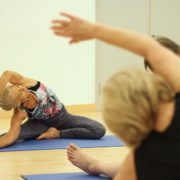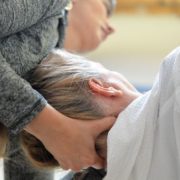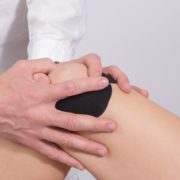Most of our clients are in their 50’s, 60’s and 70’s, and they want to stay as active as possible as they age. However, as we get older, our bodies do need more care and maintenance to age well and avoid injury. Here are some tips we like to give our clients to help them stay active and mobile, prevent injuries, and continue doing everything they love!
1. Keep Moving
I always tell my clients: “You don’t get stiff because you get old, you get old because you get stiff.”
If you want to stay healthy and mobile, you need to keep moving. One of the biggest questions I hear from folks aged 50+ is what to keep doing or stop doing because of arthritis. Remember, arthritis is normal as you age and it’s rarely a reason to stop doing certain exercises. Research has shown that activities like running, when done consistently and with proper form, can actually prevent knee arthritis! A similar and equally effective exercise is walking. Consistent walks will build up your strength and endurance, something that declines as you age, and it helps your balance and coordination. If you walk outside, you can get some fresh air and Vitamin D, which is highly beneficial for a strong immune system – something we all need right now.
2. Maintain a Healthy Diet
Tafeltennis Betting Sites Vergeleken: Winstwijzer’s Vergelijking van de Beste Opties
De wereld van het tafeltennissen is een opwindende en dynamische sport die miljoenen fans over de hele wereld aantrekt. Of je nu een doorgewinterde speler bent of gewoon geïnteresseerd in de spanning van de competitie, het wedden op tafeltennis kan een extra dimensie van opwinding en betrokkenheid toevoegen aan je ervaring. Maar met de vele online wedplatformen die beschikbaar zijn, kan het een uitdaging zijn om de juiste keuze te maken.
Gelukkig heeft Winstwijzer, een toonaangevend platform voor sportweddenschappen, een diepgaande vergelijking gemaakt van de beste tafeltennis weddenopties. In deze uitgebreide gids nemen we je mee op een reis door de wereld van het tafeltenniswedden, waarbij we de belangrijkste factoren belichten die je moet overwegen bij het kiezen van een betrouwbare en gebruiksvriendelijke wedsite. Of je nu op zoek bent naar de beste odds, uitgebreide live streaming, of een breed scala aan weddenschapsmogelijkheden, deze gids heeft alles wat je nodig hebt om een weloverwogen keuze te maken.
Betrouwbaarheid en Veiligheid
Als het gaat om tafeltennis betting sites, is het van cruciaal belang om een betrouwbare en veilige website te kiezen. Bij Winstwijzer hebben we een grondige vergelijking gemaakt van de beste opties op de markt. We hebben gelet op factoren zoals bonussen, inzetlimieten, live streaming, mobiele apps en klantenservice.
Eén van de topkeuzes is zonder twijfel Bet365, een gerenommeerde bookmaker met een uitstekende tafeltennis betting sectie. Ze bieden competitieve odds, live streaming van grote evenementen en een gebruiksvriendelijke interface. Een andere sterke optie is 888sport, bekend om hun gulle welkomstbonus en uitgebreide tafeltennis betting markten.
- Bet365
- 888sport
- Unibet
- Betway
Unibet en Betway verdienen ook een vermelding dankzij hun aantrekkelijke promoties, snelle uitbetalingen en uitstekende mobiele apps. Ongeacht welke tafeltennis betting site je kiest, zorg ervoor dat je de voorwaarden en bonusregels zorgvuldig doorneemt voordat je inzet.
Bonussen en Promoties
Tafeltennis is een populaire sport die steeds meer aandacht krijgt van gokkers. Met de groeiende belangstelling voor deze snelle en opwindende sport, is het aantal online tafeltennis weddenschap sites ook toegenomen. Bij Winstwijzer begrijpen we dat het vinden van de juiste site een uitdaging kan zijn, daarom hebben we de beste opties voor u vergeleken.
Onze experts hebben talloze factoren in overweging genomen, zoals de beschikbare wedopties, odds, bonussen en promoties, gebruiksvriendelijkheid van de site en mobiele compatibiliteit. We hebben ook gekeken naar de reputatie van de bookmakers, hun licenties en beveiligingsmaatregelen om ervoor te zorgen dat uw geld en persoonlijke gegevens veilig zijn. Bovendien hebben we de klantenservice en uitbetalingssnelheden geëvalueerd, zodat u een probleemloze ervaring kunt hebben.
- Betcity: Een uitstekende keuze voor tafeltennis fans met een breed scala aan wedopties en aantrekkelijke odds.
- Bet365: Een gevestigde naam in de gokwereld met een gebruiksvriendelijke site en een uitstekende mobiele app.
- 22Bet: Een opkomende ster met een sterke focus op tafeltennis en regelmatige promoties voor trouwe spelers.
Live Streaming en In-Play Weddenschappen
Tafeltennis is een populaire sport die steeds meer aandacht krijgt van gokkers. Met de groeiende populariteit van deze sport zijn er ook steeds meer online wedkantoren die wedopties aanbieden op tafeltennis. Winstwijzer heeft een grondige vergelijking gemaakt van de beste tafeltennis betting sites, zodat jij als gokker de juiste keuze kunt maken.
Bij het vergelijken van de verschillende sites heeft Winstwijzer gekeken naar factoren zoals bonussen en promoties, odds en wedopties, live streaming, mobiele apps en gebruiksvriendelijkheid. Daarnaast zijn ook de reputatie, veiligheid en klantenservice van de bookmakers meegenomen in de beoordeling. Met deze uitgebreide vergelijking kun je eenvoudig de tafeltennis betting site vinden die het beste bij jouw wensen en voorkeuren past.
Mobiele Apps en Gebruiksvriendelijkheid
Tafeltennis is een razendpopulaire sport die wereldwijd miljoenen fans heeft. Het is dan ook geen verrassing dat er een groeiende vraag is naar betrouwbare tafeltennis betting sites waar sportweddenschappen kunnen worden geplaatst. Winstwijzer, een toonaangevende gids voor online gokken, heeft een grondige vergelijking gemaakt van de beste opties voor tafeltennis betting. Zij hebben diverse factoren in overweging genomen, waaronder de beschikbare wedopties, odds, bonussen, gebruiksvriendelijkheid en veiligheid.
Bij het evalueren van de tafeltennis betting sites heeft Winstwijzer gekeken naar:
- De verscheidenheid aan wedopties, van wedden op individuele wedstrijden tot toernooien en meer
- De competitiviteit van de odds, zodat spelers de beste waarde voor hun inzetten krijgen
- Aantrekkelijke welkomstbonussen en promoties voor nieuwe en bestaande spelers
- Een gebruiksvriendelijke interface en mobiele compatibiliteit voor gemakkelijk wedden
- Veilige en betrouwbare betalingsmethoden en strikte licenties voor een veilige speelomgeving
Met deze criteria in gedachten heeft Winstwijzer de beste tafeltennis betting sites geselecteerd voor Nederlandse spelers, zodat ze met vertrouwen hun weddenschappen kunnen plaatsen.
Samenvattend kunnen we stellen dat de wereld van tafeltennis betting sites een breed scala aan opties biedt voor zowel recreatieve als serieuze gokkers. Door de uitgebreide vergelijking van Winstwijzer te bestuderen, krijgt u een duidelijk beeld van de sterke punten, bonussen en bijzonderheden van elke site. Of u nu op zoek bent naar de beste odds, live streaming, mobiele apps of aantrekkelijke welkomstbonussen, er is voor ieder wat wils. Neem de tijd om uw behoeften en voorkeuren te bepalen en maak vervolgens een weloverwogen keuze uit de top tafeltennis betting sites om uw gokervaring naar een hoger niveau te tillen.
What you eat directly affects your ability to keep moving. If you’re not keeping your bones and heart healthy, you’re not going to be able to exercise! Greens like kale, spinach, and arugula are awesome for your bones. Along with citrus fruits, fish, and nuts, these foods help your bones stay strong and durable, which is a big concern for our clients with osteoporosis.
When it comes to taking care of your heart, your diet can have a huge impact. According to Health magazine, “The risk of a heart attack climbs for men after age 45 and for women after age 55.” So as you enter middle-age, be sure to increase the presence of foods in your diet like unsalted nuts, unprocessed oatmeal, raisins, blueberries, and even dark chocolate (over 70% cacao) to help keep your heart healthy! If you have any comorbidities such as diabetes or kidney problems, be sure to check with your doctor or dietician before making any drastic changes to your diet.
3. Work on your Balance
Balance is one of the first things to go as a person gets older, and it’s one of the most crucial factors in helping you prevent falls and avoid injury. Slips and falls due to poor balance can lead to broken bones and fractures, which can be harder to recover from as you age. But if you’re diligent about exercising with the intention of improving your balance, you can maintain (and even improve) it far into your later years. As already mentioned, activities like walking regularly can help, along with activities such as Tai Chi and Yoga. And now, with everything so accessible via Zoom, you can take advantage of these types of activities right from your living room!
4. Strengthen your core
Having a strong core is beneficial at any age, but especially as you get older. Strong abs, hips and buttocks (all part of your core) help you to sit and stand more upright, prevent back and neck pain, and will help you feel stronger and more confident in just about everything that you do. In our office, our favorite core-strengthening activity is Pilates. We especially love it for folks aged 50+ because it’s easy on your joints and it helps to promote flexibility at the same time. We use specialized machines that are beneficial for folks recovering from an injury, and we’ve got Zoom classes requiring no equipment at all that people can do from home. Yet another reason to love Pilates is that it doesn’t just work your core, but your entire body. You can even do portions of Pilates in standing, which helps your balance and coordination! If you’ve never tried Pilates before, we’d love to help you get started.
5. Educate Yourself
Knowledge is power, and a lack of knowledge is one of the biggest reasons I see people decreasing their activity levels unnecessarily. People think that issues like arthritis, bulging discs, or a torn meniscus are reasons to decrease or cease certain activities altogether. But that’s not necessarily true! Most of the things I just mentioned are normal occurrences as we age, and having them show up on an x-ray or MRI is not a reason to change an activity you’ve been doing successfully for years. Plus, regular movement and exercise actually helps these problems.
If you have pain, that’s a different story. Talk to an expert who can help you figure out what’s going on so that you can quickly get back to your activities and not make your pain any worse. Whatever you do, try to avoid Dr. Google. It can send you down a rabbit hole and not all the advice you read will apply directly to you. If you’re dealing with pain that is keeping you from your favorite activities, reach out to experts like us. We offer a FREE 30 minute Discovery Session just so you can ask questions, get honest answers, and figure out if we’re the right fit for your lifestyle.






